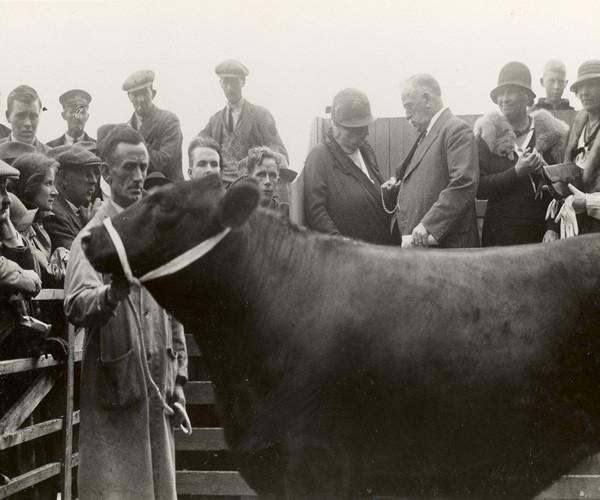This photograph is from an album commemorating Anne, Helen, and Polly's visit to a cattle auction in the town of the Royal Burgh of Dingwall, Scotland, August 1933. A handsome, large bull, shown in profile in the foreground of the picture, is in a wooden pen. A crowd stands behind the pen. Anne can be seen at the center right, looking at a gentleman's pocket watch. Helen stands behind the man and Polly stands to Helen's left. Both women wear fox furs, and all three women wear bell-shaped hats.
By 1930, Anne had less than one-tenth normal vision. Polly Thomson increasingly traveled with Helen on business engagements because Anne was physically unable to do so. That same year, under continuing pressure from Dr. Conrad Berens for Anne to convalesce, the three women took their first trip to Scotland, England, and Ireland.
The vacation brought Anne much needed rest and recuperation. In the photograph shown here, Anne, Helen, and Polly visit a cattle auction in the town of the Royal Burgh of Dingwall. The auction of bullocks raised funds for the deaf-blind of Scotland.
The Irish leg of the trip was full of mixed emotions for Anne, who was returning to the country her parents had emigrated from. Anne felt an intense connection to Irish culture, history, and politics. She wrote the following in "Foolish Remarks of a Foolish Woman":
Only an Irish love of politics has kept alive my interest in world affairs. Some of my friends say I am the best letter-writer they know. I do not take my opinions from others. I am not bound by traditions or dogmas, and it seems to me that I have no reverence.
She was filled with sadness at the mournful beauty of Ireland and was uncomfortable traveling in a luxury Daimler car when those around her were so visibly poor, just as she had once been. The following excerpt is from Nella Braddy Henney's book Anne Sullivan Macy:
There is nothing in the world, it seems to me, like the sadness that prevails in parts of Ireland. It is the accumulated sadness of centuries of hunger, evictions, and emigrations.
It is impossible for anyone in whose veins flows Irish blood to stand on the quay of any port in the country without heartache and tears. For countless thousands have boarded ships there, leaving forever the land of their birth. There broken-hearted mothers have hung upon the necks of young sons and daughters in a last embrace...clearly, oh, so clearly, I heard my father bidding his father and mother good-bye, clinging to them until the ship pulled them apart and bounded out to sea.
These ports are wounds that Ireland cannot staunch. From them pours a constant stream of her best and strongest blood. Rooks cawing and circling about the quays—are they the souls of the unhappy emigrants returning at last to their native shores?
The grandeur of the country is founded on homesickness.
